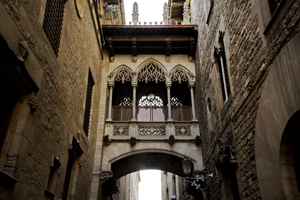 This neogothic-style bridge at Carrer del Bisbe in Barcelona was designed by architect Joan Rubió and built in 1928.
This neogothic-style bridge at Carrer del Bisbe in Barcelona was designed by architect Joan Rubió and built in 1928.
Christopher Chomer ’13 will always have Barcelona. It’s there in his mind, a spot to return to again and again for inspiration as he did earlier this school year while working on a design project for a landscape architecture studio class. When considering how he wanted a pedestrian area near a waterfront to look, his thoughts went to La Rambla, the famous, mostly-pedestrian boulevard that winds through the center of Barcelona. He recalled how the placement of trees and vendors directed people through the area, how the linking of small areas with open ones created inviting spaces to congregate. With these memories, he added similar concepts to his own project.
“I wouldn’t have created a design like that if I hadn’t been to Barcelona and moved around in that space,” said Chomer, who visited the Spanish city while spending his fall semester in Bonn, Germany, as part of the College of Architecture’s study abroad program. “I think it was key that I had real world experience to draw on. I wasn’t just going on Pinterest and looking up ‘landscape architecture.’”
Because architecture is a profoundly three-dimensional discipline, it is best understood that way. This is the idea that 15 years ago prompted Thomas Regan, then dean of the College of Architecture, to mandate that his students spend a semester away from Texas A&M University—either in an internship or studying abroad. In the majority of departments in the College of Architecture, students prefer the study abroad option if they can afford it. Because the architecture courses overseas match up with those on campus and are taught by Texas A&M professors or adjunct faculty, students can stay on track with their degree plan while experiencing a far different environment. With this requisite, the College of Architecture has a higher percentage of students studying abroad than any other college at Texas A&M. “Tom believed it shook students up that it magnified their level of learning,” said Elton Abbott, assistant dean for international programs at the College of Architecture. “It’s one thing to study slides and quite another to walk around buildings, to touch them and talk about them. Learning is much more effective in the 3-D world. The experience turns ‘C’ students into superstars.”
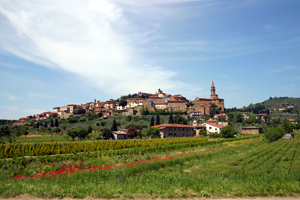 Castiglion Fiorentino is the setting for the college's oldest study abroad program.
Castiglion Fiorentino is the setting for the college's oldest study abroad program.
The College of Architecture has four main international options for its students to extend Texas A&M’s global reach. In Italy, the Tuscan town of Castiglion Fiorentino (population 12,000) has been the gorgeous setting for the college’s oldest study abroad program for 25 years. The stone buildings in this walled hilltop enclave, which dates back to the seventh century, have red tile roofs and are rich in character. One of them is a 17th century former con vent that has been converted into the Santa Chiara Study Center, where students live and take classes in design, Italian arts and civilization. “Our joke over the semester was that we felt like we were living at Hogwarts,” said Abbe Emerson ’15, a senior environmental design major who spent the 2013 fall semester with about 35 other College of Architecture students at Santa Chiara. (Texas A&M students from other majors are allowed in the program, but architecture students dominate.)
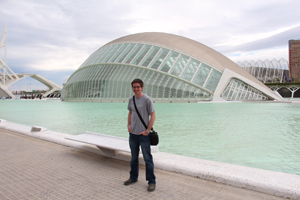 Brian Sowell '14 studied in Barcelona because the program emphasized modern architecture.
Brian Sowell '14 studied in Barcelona because the program emphasized modern architecture.
The fantasy element extends beyond housing. Students make regular visits to nearby cities like Florence an hour away by train—and longer field trips to study the classical architecture in Rome and Venice. “In addition to studying architecture and landscapes,” Emerson said, “I grew as a student, a person and a worldly citizen.” Brian Sowell ’14 chose to study in Barcelona during the spring 2013 semester rather than Italy because he wanted an urban experience. The Barcelona program emphasizes modern architecture, which is fitting since this city of 1.6 million is known for its innovative designs (including those by renowned architect Antoni Gaudi). Students in the Barcelona Architecture Center program live in apartments separate from the study area. After Sowell’s classes and his midday siesta, he regularly wandered through the city, observing not just eaves and entryways but how people interacted with each other and the architecture. Over time he began to re-think his design philosophy.
“If a building is private in the United States, you often think only about what’s happening within the property line,” said Sowell, who graduated this spring. In Barcelona, he saw how buildings related to other structures and encouraged social discourse and interaction. “No one wants to hang out at a strip mall,” he commented. “I want to figure out how to elevate design so people are encouraged to interact and connect. It’s a concept of giving back to a city.”
His time in Europe—including a field trip to the Netherlands, a country also known for its modern architecture had a direct impact on the next step in his career. On graduate school applications, he was able to discuss architecture principles in more detail. “I don’t think I had the maturity before,” he explained. “Barcelona really refined my idea of what I wanted to do in my career.”
Many of the students taking their semester in the third location option—Bonn, Germany—are studying landscape architecture or visualization.
 Bonn excels at integrating environmental aspects into building designs and city planning.
Bonn excels at integrating environmental aspects into building designs and city planning.
Germany excels at integrating environmental aspects into building designs and city planning. Students in this program, operated by the Academy for International Education, live with host families to experience deeper cultural enrichment.
“In Bonn, we focused a lot on conservation, like reusing rainwater,” said Chris Chomer. “My host family harvested rainwater and grew their own fruit. I had homemade plum cake about a million times.”
Construction Science majors have the option of combining an internship with a study abroad experience in London. The semester there, called Wingtips, Work Boots & Wigs, focuses primarily on legal and risk management in the U.S. and other countries. An international bonus for all architecture students is a popular course on innovation and creativity taught every winter break by Dean Jorge Vanegas at the Soltis Center for Research and Education in Costa Rica.
About 30 percent of architecture students do not study abroad, choosing instead a one-semester domestic internship (usually paid), said Abbott. The hindering factor for these students is often financial: the cost for a semester overseas is about double that of a semester in College Station. Sowell estimated that he spent a total of $20,000 for his semester in Barcelona—an amount he patched together through a summer job, a loan and several scholarships.
Students who can’t afford to study overseas can apply for partial scholarships—up to $3,000 from the College of Architecture—or for study abroad scholarships administered by the Office of Scholarships and Financial Aid and the Study Abroad Programs Office. But often it’s not enough to get students over the financial hurdle. “I had a student here the other week who really wanted to go to Italy, but it was just going to be too hard on her family to do it,” Abbott said. “It breaks my heart.” He stressed, however, that no one is looked down upon or penalized for not going to Europe.
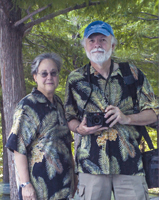 Mikeual '69 and Laura Perritt '72 generously support study abroad programs.
Mikeual '69 and Laura Perritt '72 generously support study abroad programs.
“I wish we had enough money to cover the difference between a semester at College Station and a semester abroad for everyone,” Abbott said. And there are many people who share this wish, including Mikeual ’69 and Laura Perritt ’72, both retired architects living in Alexandria, Virginia. The couple made an estate gift to the College of Architecture to provide scholarships to students who want to explore environmental design in Bonn (or in China, if the college ever establishes a program there). “One of the things that has helped us most in our careers is exposure to other cultures,” said Mikeual. “In Germany, you get to see how they take care of public transportation and how they’re developing solar and wind energy and sustainable building practices. They’re significantly ahead of most countries.”
The Perritts applaud the College of Architecture’s semester away policy, but realize they couldn’t have afforded to study abroad if it was in place while they were at Texas A&M.
Their desire that no student miss out is part of the motivation for their gift. “There are enough former students doing well,” said Mikeual. “If they could just donate something, it would make studying overseas so much easier for students.”
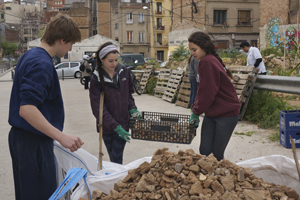 Amy Brodeur '14 and Gabrielle Fernandez '16 help remove rocks from an area students later converted into a community garden as part of the Big Event in Barcelona.
Amy Brodeur '14 and Gabrielle Fernandez '16 help remove rocks from an area students later converted into a community garden as part of the Big Event in Barcelona.
But it’s not just the Texas A&M students who benefit from these study abroad programs; the host cities gain something as well. Last spring, students at three study centers went global with the Big Event, Texas A&M’s annual day of service to give back to the community. In Bonn, Aggies cleaned up green spaces at Beethoven Haus, a chamber music hall, and planted a garden at a retirement home. Aggies in Barcelona joined Architects Without Borders to plant vegetables and build a fence in one of the city’s neighborhoods. In Castiglion Fiorentino, students helped clean ceramic fragments dating back to the Roman Empire and painted a mural in a middle school classroom.
“It was a great way to show our Aggie spirit to our global partners,” said Abbott. The town of Castiglion Fiorentino got a bonus from the Texas A&M students there last fall: a novel plan for a new community center. As part of a design competition, Abbe Emerson ’15 and two other Aggies created demonstration kitchens on top of a much-needed parking garage as a way to help the town promote tourism. Their kitchen concept won first place in the competition against architectural students from other big U.S. universities at the Santa Chiara Study Center. The team’s idea was for locals and tourists to take cooking classes led by chefs who combine the flavors of Tuscany with American and other world cuisines.
Eleven of the Aggies who study abroad acknowledge the importance and rewards of bringing cultures together. Through his experiences in Spain and Germany, Chris Chomer said his mind was liberated.
“I now think about the environment a lot more when I am designing,” said Chomer, who after his graduation this spring began working at Edminster, Hinshaw, Russ & Associates, a Houston engineering firm. “Since my study abroad, I feel so much more creative, and not nearly as limited. It was truly a life-changing adventure that future Aggies should explore.”
By Jeannie Ralston
This article was originally published in the summer 2014 issue of Spirit magazine. Read the full publication.
Texas A&M Foundation
The Texas A&M Foundation is a nonprofit organization that solicits and manages investments in academics and leadership programs to enhance Texas A&M’s capability to be among the best universities.